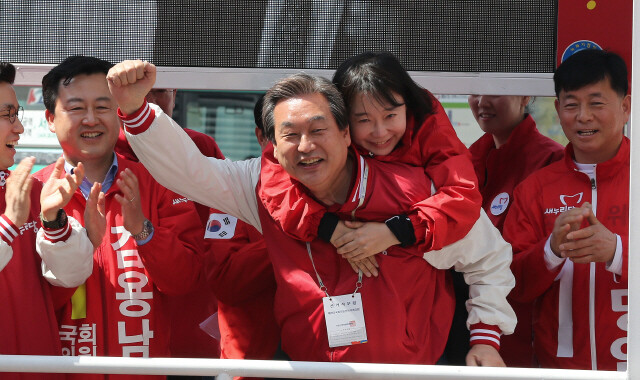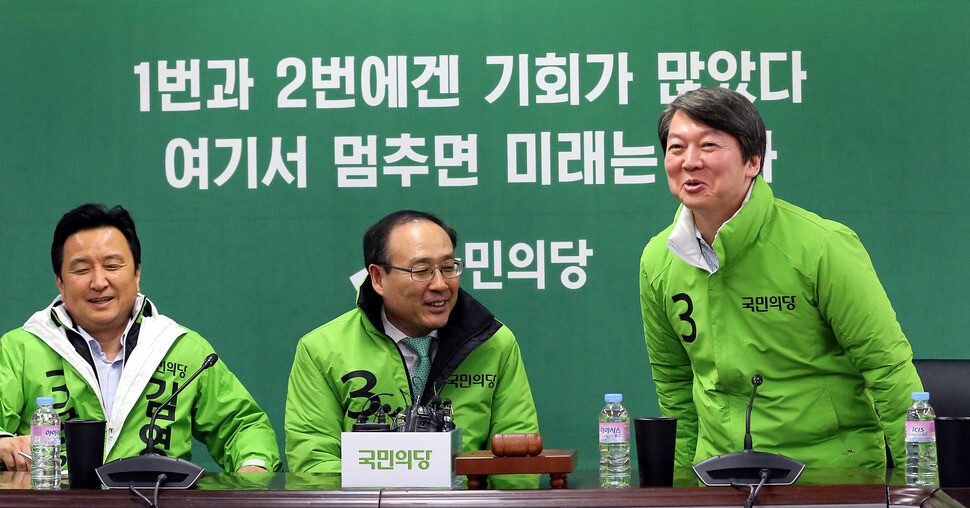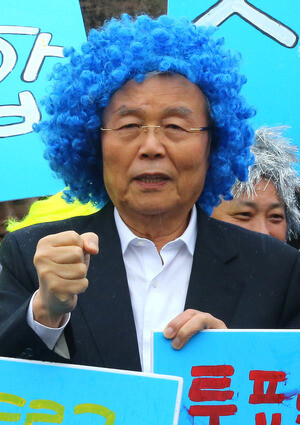hankyoreh
Links to other country sites 다른 나라 사이트 링크
[Analysis] Three big keywords ahead of Apr. general election
With multiple opposition parties going up against the ruling party in the Apr. 13 general elections, the main issue is shaping up to be the economy. Now that the alignment and issues have come into focus, the forces likely to shape the post-election landscape are becoming apparent. The developments to watch can be summed up in the three keywords below.

The first question is whether the Saenuri Party and affiliated independents will be able to gain at least 180 seats. While pundits had initially been wondering whether the Saenuri Party would gain 180 seats by itself, the situation has changed somewhat after a number of lawmakers left the party following the tumultuous candidate nomination process.
There are 10 independents aligned with the Saenuri Party in the southeast Gyeongsang region (traditionally a conservative stronghold) with a chance of being elected, including Yoo Seung-min in Daegu (East B District). If they win, there is a good chance that they will rejoin the Saenuri Party soon after.
The same goes for Lee Jae-oh in Seoul, Eunpyeong B District; Kim Yeong-sun in Seoul, Songpa B District; and Yoon Sang-hyun in Incheon, South B District. For this reason, they should be added to the total.
If the Saenuri Party gets more than 180 seats, it will revise the National Assembly Advancement Act during this session. It will also move ahead with a number of labor bills that deal with temp work and short-term work and with the Anti-Terror Act, which President Park Geun-hye has been pushing. This would effectively add a burst of nitro to Park’s breakneck pace.
There is also a possibility of a push for constitutional reform to bring in a decentralized presidential system or a parliamentary system. It would not be too hard for the Saenuri Party to recruit 20 or so opposition lawmakers for such an effort.
If the Saenuri Party and its affiliated independents fail to reach 180 seats, however, the result is that Park will not have the power to push forward her agenda for the country.
This is also likely to intensify the power struggle inside the party, and there would probably be a clash between the pro-Park and anti-Park factions in the party convention held shortly after the parliamentary elections. If the situation gets out of control, Park could even become a lame duck sooner than expected.

If the People’s Party, led by Ahn Cheol-soo, manages to set up a parliamentary group, this would be the first time there were three parliamentary groups in the National Assembly in 20 years, since the United Liberal Democrats won 50 seats in 1996. This could usher in a time of dialogue and compromise - or a time of roughshod rule by a massive ruling party.
But there is a good chance that the People‘s Party will become the party of the Jeolla region, a traditional liberal stronghold in the southwest corner of the peninsula. This is because most of the party’s candidates in the district elections are from Jeolla.
According to recent opinion polls, about the only People‘s Party candidate with a chance of being elected in the capital region is Ahn Cheol-soo himself, the party leader.
While the Party for Peace and Democracy was called the “Jeolla Party” after the 1988 election, it did win 17 seats in Seoul. The objective reality is that the People’s Party is very likely to become the first ever actual Jeolla Party.
After the election, it appears likely that supporters of the opposition will have to enter a major discussion about realigning the Jeolla Party and the opposition. They will be spurred on by the need to prepare for the presidential election next year.
There is likely to be complex and contentious debate about such questions as who should be held responsible for the split in the opposition and its defeat in the parliamentary elections and whether it would be possible to realign the opposition around the Jeolla Party.
If Ahn Cheol-soo and the lawmakers of the People’s Party manage to craft a political platform and exhibit leadership that can win over the hearts of the people, they will emerge as the new core of the South Korean opposition.
But if they fail to do so, they could be reabsorbed into the two-party system. This is what happened to Jeong Ju-yeong’s United People’s Party, which appeared in 1992 only to disappear shortly thereafter.
3. 100 seats
Can the Minjoo Party of Korea win more than 100 seats? If the party fails to do so, the political responsibility will fall on the shoulders of party leader Kim Jong-in. Former party leader Moon Jae-in would also find it hard to shirk responsibility for failing to prevent the split in the opposition party.
This would place the Minjoo Party in danger of finding itself in a leadership vacuum.
The immediate issue is the party convention, which is held after the election.
Some segments of the party say that it is time to pass the torch to the next generation, namely the younger lawmakers who will be elected on Apr. 13. Others say that Sohn Hak-kyu, a former party leader who has since retired from politics, should be asked to return and assume the party mantle.
But at this point, everything is up in the air. If the lawmakers, party members and supporters of the Minjoo Party fail to remake the party, South Korea will find itself in the unprecedented situation of the disintegration of the leading opposition party and a realignment of the political opposition.
But even if the party does win at least 100 seats, it will probably still have to endure a period of chaos. There could be friction as the choices of party leader Kim Jong-in come into conflict with the actions of those vying for control of the party.
By Seong Han-yong, political correspondent
Please direct questions or comments to [english@hani.co.kr]

Editorial・opinion
![[Column] Has Korea, too, crossed the Rubicon on China? [Column] Has Korea, too, crossed the Rubicon on China?](https://flexible.img.hani.co.kr/flexible/normal/500/300/imgdb/original/2024/0419/9317135153409185.jpg) [Column] Has Korea, too, crossed the Rubicon on China?
[Column] Has Korea, too, crossed the Rubicon on China?![[Correspondent’s column] In Japan’s alliance with US, echoes of its past alliances with UK [Correspondent’s column] In Japan’s alliance with US, echoes of its past alliances with UK](https://flexible.img.hani.co.kr/flexible/normal/500/300/imgdb/original/2024/0419/2317135166563519.jpg) [Correspondent’s column] In Japan’s alliance with US, echoes of its past alliances with UK
[Correspondent’s column] In Japan’s alliance with US, echoes of its past alliances with UK- [Editorial] Does Yoon think the Korean public is wrong?
- [Editorial] As it bolsters its alliance with US, Japan must be accountable for past
- [Guest essay] Amending the Constitution is Yoon’s key to leaving office in public’s good graces
- [Editorial] 10 years on, lessons of Sewol tragedy must never be forgotten
- [Column] A death blow to Korea’s prosecutor politics
- [Correspondent’s column] The US and the end of Japanese pacifism
- [Guest essay] How Korea turned its trainee doctors into monsters
- [Guest essay] As someone who helped forge Seoul-Moscow ties, their status today troubles me
Most viewed articles
- 1[Column] The clock is ticking for Korea’s first lady
- 2[Correspondent’s column] In Japan’s alliance with US, echoes of its past alliances with UK
- 3Samsung barricades office as unionized workers strike for better conditions
- 4After 2 months of delayed, denied medical care, Koreans worry worst may be yet to come
- 5[Column] Has Korea, too, crossed the Rubicon on China?
- 6[Editorial] When the choice is kids or career, Korea will never overcome birth rate woes
- 7Hong Se-hwa, voice for tolerance whose memoir of exile touched a chord, dies at 76
- 8US overtakes China as Korea’s top export market, prompting trade sanction jitters
- 9Constitutional Court rules to disband left-wing Unified Progressive Party
- 10Nearly 1 in 5 N. Korean defectors say they regret coming to S. Korea